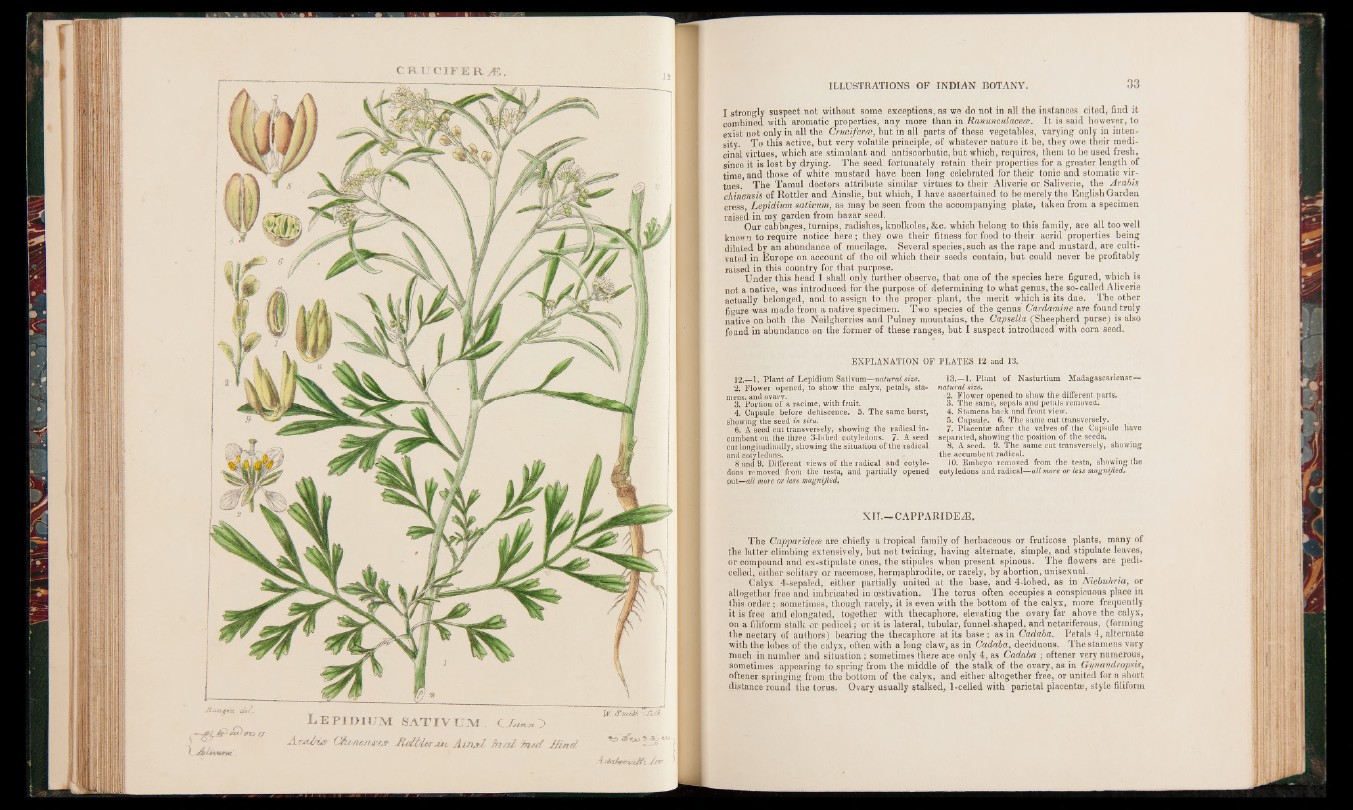
Jluxigia, clei.
iü) cm cr
CRUCIFERÆ,
L E P ID IU M S A T IV UM . CE*wO
AwAf CPu'/iC'??/?.^? Jtdt/Lôrxn, Jliài&l 9na£ 9m d .Hind
W- &vci£A .Jü/Ü
^ y «M 5 5o *»
A ctaUvvidi /t*>
I strongly suspect not without some exceptions, as we do not in all the instances cited, find it
combined with aromatic properties, any more than in Ranunculacece. It is said however, to
exist not only in all the Cruciferce, but in all parts of these vegetables, varying only in intensity.
To this active, but very volatile principle, of whatever nature it be, they owe their medicinal
virtues, which are stimulant and antiscorbutic, but which, requires, them to be used fresh,
since it is lost by drying. The seed fortunately retain their properties for a greater length of
time and those of white mustard have been long celebrated for their tonic and stomatic virtues.
The Tamul doctors attribute similar virtues to their Aliverie or Saliverie, the Arabis
chinensis of Rottler and Ainslie, but which, I have ascertained to be merely the English Garden
cress, Lepidium sativum, as may be seen from the accompanying plate, taken from a specimen
raised in my garden from bazar seed.
Our cabbages, turnips, radishes, knolkoles, &c. which belong to this family, are all too well
known to require notice here; they owe their fitness for food to their acrid properties being
diluted by an abundance of mucilage. Several species, such as the rape and mustard, are cultivated
in Europe on account of the oil which their seeds contain, but could never be profitably
raised in this country for that purpose.
Under this head I shall only further observe, that one of the species here figured, which is
not a native, was introduced for the purpose of determining to what genus, the so-called Aliverie
actually belonged, and to assign to the proper plant, the merit which is its due. The other
figure was made from a native specimen. Two species of the genus Cardamine are found truly
native on both the Neilgherries and Pulney mountains, the Capsella (Sheepherd purse) is also
found in abundance on the former of these ranges, but I suspect introduced with corn seed.
EXPLANATION OP PLATES 12 and 13,
12.—1. Plant of Lepidium Sativum—natural size.
2. Flower opened, to show the calyx, petals, sta-
jnens, and ovary.
3. Portion of a racime, with fruit.
4. Capsule before dehiscence. 5. The same burst,
showing the seed in situ.
6. A seed cut transversely, showing the radical incumbent
on the three 3-lobed cotyledons. 7. A seed
cut longitudinally, showing the situation of the radical
and cotyledons.
8 and 9. Different views of the radical and cotyledons
removed from the testa, and partially opened
put—all more or less magnified^.
13.—1. Plant of Nasturtium Madagascariense—•
natural size.
2. Flower opened to show the different parts.
3. The same, sepals and petals removed.
4. Stamens back and front view.
5. Capsule. 6. The same cut transversely.
7. Placen’tffi after the valves of the Capsule have
separated, showing the position of the seeds.
8. A seed. 9. The same cut transversely, showing
the accumbent radical.
10. Embryo removed from the testa, showing the
cotyledons and radical—all more of less magnified,
X II.—CAPPARIDEA3,
The Capparidece are chiefly a tropical family of herbaceous or fruticose plants, many of
fhe latter climbing extensively, but not twining, having alternate, simple, and stipulate leaves,
or compound and ex-stipulate ones, the stipules when present spinous. The flowers are pedi-
celled, either solitary or racemose, hermaphrodite, or rarely, by abortion, unisexual.
Calyx 4-sepaled, either partially united at the base, and 4-lobed, as in Niebuhria, or
altogether free and imbricated in aestivation. The torus often occupies a conspicuous place in
this order; sometimes, though rarely, it is even with the bottom of the calyx, more frequently
it is free and elongated, together with thecaphore, elevating the ovary far above the calyx,
on a filiform stalk or pedicel; or it is lateral, tubular, funnel-shaped, and netariferous, (forming
the nectary of authors) bearing the thecaphore at its base : as in Cadaba. Petals 4, alternate
with the lobes of the calyx, often with a long claw, as in Cadaba, deciduous. The stamens vary
much in number and situation ; sometimes there are only 4, as Cadaba ; oftener very numerous,
sometimes appearing to spring from the middle of the stalk of the ovary, as in Gynandropsis,
oftener springing from the bottom of the calyx, and either altogether free, or united for a short
distuuce round the torus. Ovary usually stalked, l-celled with, parietal placentas, style filiform